15 Types of Dogwood Trees To Bring Flowering Beauty to Your Lawn
Author: Rick Worst | Editor: Omar Alonso
Review & Research: Jen Worst & Chris Miller

Dogwood trees can enhance the beauty of your garden by great lengths. There are a total of 17 types of dogwood trees that are native to North America.
Among these, four species are found most commonly in the gardens. Two of these are native, and two aren't, but they gained immense popularity because of their disease resistance.
As you can see, even though these are plants from the same family, there's a lot of differences in their characteristics. That is why it's important to know what you're getting beforehand. And this article will help you with that.
15 Types of Dogwood Trees
Here you'll learn about some of the most common types of dogwood trees in detail. To further your exploration, you could consider visiting the US National Arboretum's Dogwood collection in person. But before that, let's look at what we have for you below.
Common Dogwood
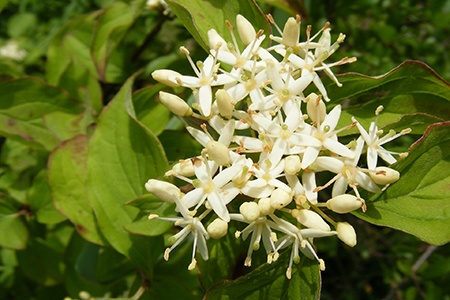
This type of dogwood, known as Cornus sanguinea, is native to Europe and Western Asia. You may also know them as European dogwood and Bloodtwig dogwood.
It's a kind of shrub that grows multiple stems. These are also known to bloom dull-white by the end of Spring, and they have both elliptical and oval leaves.
However, the flowers will turn into blue-black berries in Autumn, and these berries are toxic and should not be consumed by humans.
The leaves of these trees usually display a beautiful purple-red hue in fall, and this is when they look the best.
The stems of the plants may have a red color when they're young. However, that color will slowly turn green while the plant matures. If you plant one of these in your garden, make sure to prune it once a year, or it'll grow out of control.
Kousa Dogwood
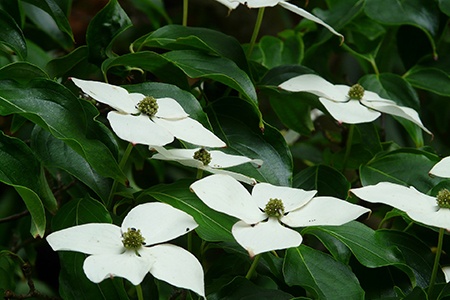
Kousa dogwood trees (Cronus kousa) are also known as Japanese dogwood trees, and some people call them Chinese dogwood as well. So, if you hear both Japanese and Chinese dogwood, don't get confused because they're the same thing.
These aren't native to North America. As their name suggests, they've come from Asia. However, their ability to adapt to North American climate and ornamental purposes quickly became popular.
You'll find these trees showing off beautiful yellow-green flowers in Spring, which gradually leads to reddish-pink fruits in the Summer. The fall foliage of these trees is usually purple in the beginning, but they become red later.
The tan or grey bark of these trees also looks fantastic. They also have an exfoliating texture that looks amazing in the winter. If you want to display the stem, then you should prune the branches regularly.
Mountain Dogwood
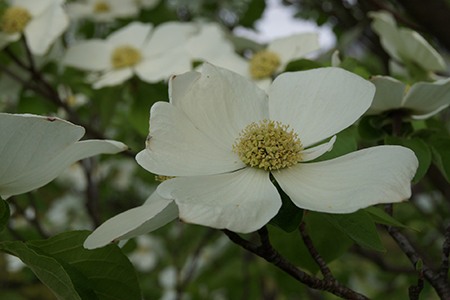
The Mountain dogwood is also known as the Pacific dogwood, or scientifically as Cornus nuttallii, and it's a medium-sized tree. The Mountain dogwood being a deciduous tree features excellent tolerance against drought conditions and shady locations.
So, if you live somewhere that isn't suitable for other dogwood species, you can try getting one of these types of dogwood trees.
A significant difference between Mountain dogwood and the other dogwood species is that the white bloom of the Mountain dogwood is far bigger.
The fall foliage of these trees can be red, yellow, or orange. These also produce berries, and they are either orange or bright red.
Plus, not all localities will allow you to plant these, so you better check your local regulations before planting one of these. If you find fallen leaves stacking around the trunk of the plant, you better clear them soon, or they'll get fungus.
These can grow very tall as well, approximately 82 feet. So, you better plant them in open spaces.
Cornelian Cherry Dogwood
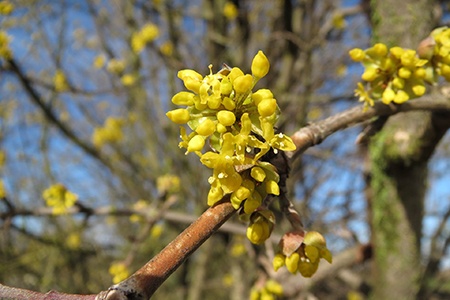
Next up, we have the Cornelian Cherry (Cornus mas), also known as the European Cornel. It's like a dogwood shrub, and it also sprouts very early each season.
In fact, the blooms show up even before the leaves sprout in early Spring, making this one of the dogwood varieties that bloom the earliest.
You'll get yellow flowers that bloom oval foliage from these trees. The oval foliage is usually four inches in length. The best part of this dogwood tree is that its fruits can be harvested once they're ripe.
Then again, the fact that the fruits of this tree are edible and can be used as an ingredient for preparing sauces, jams, as well as liquor makes them worth planting.
Flowering Dogwood
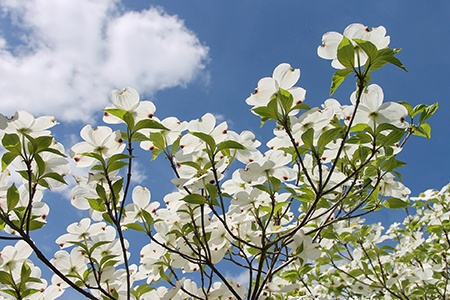
Flowering dogwood, known as Cornus florida, is one of the most common types of dogwood trees that you'll come across. It's also the state tree of North Carolina. It is a deciduous plant, and it can sprout red, pink, or even white flowers when Spring begins. The pink dogwoods, in my opinion, go very well with any types of redbud trees, too.
In fall, the green leaves of this species turn deep red, and they start producing fruit slowly. The branches will display small buds on their tips in winter. This classic dogwood is what helped the dogwood become a candidate for the national tree.
If your garden is in a spot that receives a ton of afternoon shade and has acidic soil, then the Flowering dogwood would be an excellent choice for you.
These can grow up to 20 feet, and their trunks can be as wide as 12 inches. So, you better plant them in with some extra space in mind.
Despite their beautiful appearances, these are prone to dogwood anthracnose. However, it'll be very easy for you to control this if you prune this tree once every year.
To ensure the healthiest life for this tree, make sure it gets at least four hours of sunlight each day and that you know the best time to plant fruit trees.
Canadian Bunchberry Dogwood
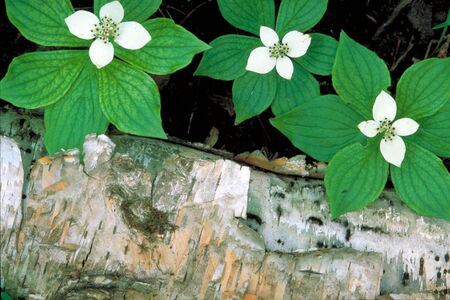
The chances are that you've already heard of the Cornus canadensis, but you know these dogwood tree types as Bunchberry only. These are common plants, and they're also called Dwarf Cornel in many regions.
They aren't as tall as the other dogwood trees. In fact, they grow very low to the ground and have foliage that's dark green.
These shrubs feature white flowers in Spring, and these flowers eventually turn to bright red fruits in Summer. Thankfully, these berries are edible for humans.
The biggest advantage these trees offer is the low space requirement. If you have a small garden but want to plant a dogwood tree, then the Canadian Bunchberry is the perfect choice for you.
These plants are native to northeastern Asia, North America, and Greenland, and they grow rapidly in partial shade.
The highest they can reach from the ground is six inches, and some plants may be restricted to four inches even, depending on the environment and nutrition provided.
Gray Dogwood
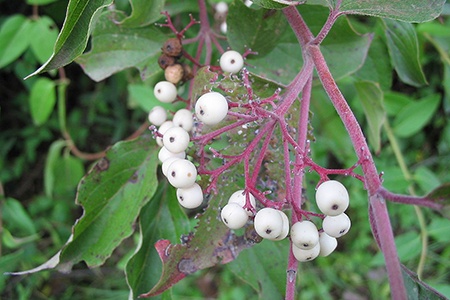
The Gray dogwood trees (Cornus racemosa) are known as northern swamp dogwood in many places. These deciduous shrubs are native to eastern parts of North America, and the regions are Canada, Vermont, New Hampshire, and Maine.
These aren't called gray dogwood because their stem is gray; instead, it's because of the grayish hue of the leaves. As the rhizome of these plants spread underground, the shrubs slowly form thickets.
You'll get white fruits from these flowers in the Summer, and these fruits are produced by white flowers that bloom in late Spring, making these types of dogwood trees enjoyable for many seasons.
The berries produced by these trees are edible for birds but can't be eaten by humans. You'll also find the bark fading to a gray hue as the plant matures.
Pagoda Dogwood
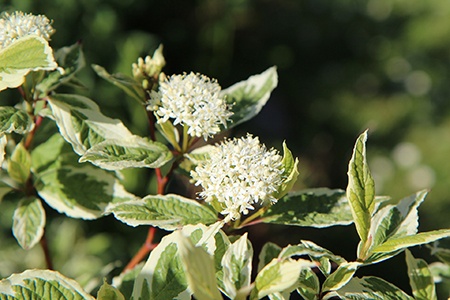
The Pagoda dogwood trees, known as Cornus alternifolia) are one of the few dogwoods that feature alternatively arranged foliage. That is why they are commonly known as alternate-leaf dogwood in most places.
Although it's a multi-stemmed shrub, you can make it look like a tree if you can prune it accordingly using the right types of saws. Then again, these won't grow thicker than six inches, and the branches will grow horizontally, so they can't be made to look like a full-fledged tree.
Overall, if you want to plant a beautiful dogwood tree but don't have enough space, you can consider planting this one.
Red Osier Dogwood
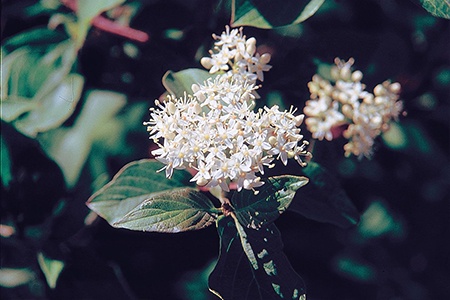
The Red Osier dogwood tree is native to North America, so it's known to grow well in most of the regions. It's called by many names as well, but this is the one that'll be recognizable to all. The USDA hardiness zone is 2 to 7.
As it's grown mostly in wet areas, it's incredibly tolerant of floods. It can grow up to 12 feet and features oval leaves and white flowers. It's often referred to as Red Osier dogwood and scientifically as Cornus sericea.
Siberian Dogwood
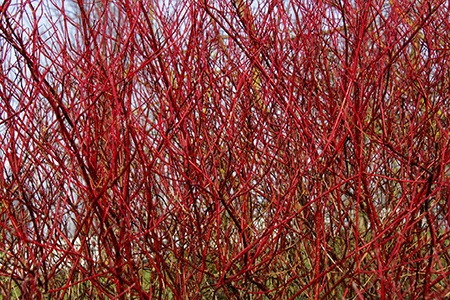
Finally, we have the Siberian dogwood (Cornus alba), which is also known as red-barked dogwood and white dogwood. These dogwood varieties are more of a shrub than a tree.
If you prune the branches well, you'll be able to give it the looks of a miniature tree. It's not the showiest tree, but it can make your garden more beautiful with its red stems, white berries, and dark green foliage.
These trees grow the best in full sun or partial shade. They need at least six hours of sunlight per day to grow healthy.
Himalayan Dogwood
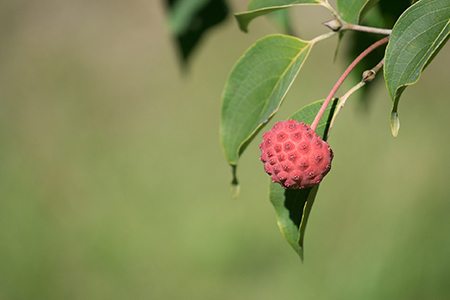
Classified as Cornus capitata by scientists, depending on where you live people call it by other names such as the Himalayan Strawberry Tree, Evergreen Dogwood, and Betham's Cornel.
Though the strawberry looking fruit is the most striking visual feature, wait until summer when you see it bloom its white flowers.
If you want to see these types of dogwood trees in their native habitat you'll need to travel to Asia and Australia, but fear not because it can thrive in any similar latitude.
Stiff Dogwood
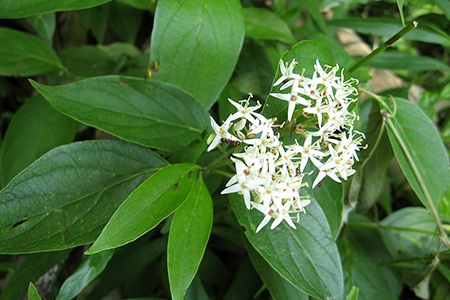
Depending on who you ask, the Stiff Dogwood may be called the Swamp Dogwood, though it's officially called Cornus foemina. This is an interesting tree to observe, because the colorful red twigs eventually spawn white flowers and blue fruit.
The cymes, which are the bundles of white flowers, have a potent smell that most find to be unpleasant. Don't grow it if that'll bother you because once it reaches maturation at around 17-25 feet in height, it'll produce much of that odor.
It's called swamp dogwood by many because these kinds of dogwood trees grow in swamps and in marshes or anywhere else with access to lots of water. It can live in dry areas but it really craves the moisture.
Brown Dogwood
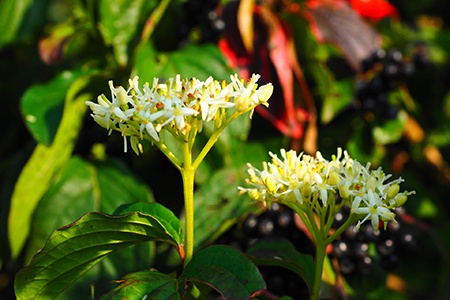
Known as the Cornus glabrata, you may find others referring to the Brown Dogwood as a Smooth Dogwood or Western Cornel (especially in its native lands of Oregon and California).
This dogwood species is dense enough that several of them as a shrub can form a thicket, making it difficult for even animals to pass through since branches can sag to the ground.
It's a colorful plant, with reddish brown bark, with green leaves that can become red during autumn and then white in the spring. These fuzzy leaves and branches are terminated by blue fruits on the end.
Rough Leaf Dogwood
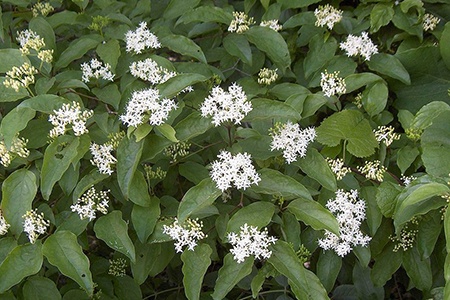
Cornus drummondii is called Rough Leaf Dogwood by the masses mainly because the leaves produce thicker, course hairs compared to other types of dogwood trees. They're a versatile variety of dogwood trees, capable of being a shrub, bush, or small tree.
If you want it to produce more flowers and berries, plant it in an area that receives full sunlight. It can thrive well in the shade, but it won't produce as many fruit or flowers.
These fruit are white berries that will show up in the summer and lead into the fall where the foliage begins to take on a reddish tint. It prefers moist environments which is why it's often found around the Mississippi River.
Giant Dogwood
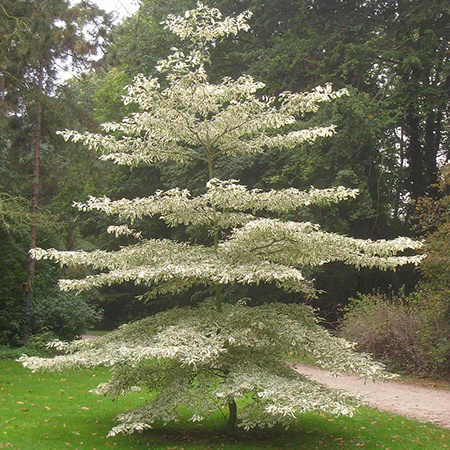
And finally we have Cornus controversa, the Giant Dogwood Tree. Many people call it the Wedding Cake Tree around its native regions near the Himalayas and around Asia.
These varieties of dogwood trees can grow quickly and reach a height as vast as 50 feet. The dark green leaves create a beautiful backdrop to the white spring blooms and blue summer fruit. The leaves themselves turn a purple-red in the fall.
Types of Dogwood Trees for Every Lawn
As you can see, each dogwood tree species is very different from the other, so it's important to know what you're getting from a specific type. We highly recommend studying the different types of dogwood trees before making the purchase.



